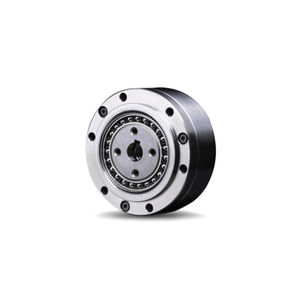
- Power Transmission - Mechanical components
- Mechanical Transmission
- Strain wave gear reducer
- Reach Machinery Co.,Ltd.
Strain wave gear reducer RHSG seriesharmoniccoaxialhollow-shaft
Add to favorites
Compare this product
Characteristics
- Type
- strain wave, harmonic
- Shaft orientation
- coaxial
- Shaft configuration
- hollow-shaft
- Applications
- for servo motors, for robots, for medical applications, for machinery, for telecommunications equipment, electronic equipment, for aeronautical applications, for laser applications
- Other characteristics
- mechanical transmission
Description
Strain Wave Gear, is the use of metal flexibility, elastic mechanics and other principles, relying on flexible parts to produce elastic mechanical waves to transmit power and motion of a planetary gear transmission.
Harmonic gear transmission principle
Harmonic gear transmission was invented by American inventor C.W. Musser in 1955. It is a new type of transmission method that uses the elastic deformation of flexible components for motion or power transmission, which breaks through the mode of mechanical transmission using rigid component and uses a flexible component to realize mechanical transmission, thus obtaining a series of special functions that are difficult to be achieved by other transmissions. Its name comes from the fact that the deformation process of the middle flexible component is basically a symmetrical harmonic. In addition to the Soviet Union, this kind of transmission is called wave transmission or flexspline transmission, the United States, Britain, Germany, Japan and other countries are called "harmonic transmission".
Advantages
Harmonic gearing has some advantages over traditional gearing systems:
No backlash
Compactness and light weight
High gear ratios
Reconfigurable ratios within a standard housing
Good resolution and excellent repeatability (linear representation) when repositioning inertial loads
High torque capability
Coaxial input and output shafts
High gear reduction ratios are possible in a small volume
Applications
Strain wave gears are widely used in robots, humanoid robots, aerospace, semiconductor manufacturing equipment, laser equipment, medical equipment, metal processing machinery, drone servo motor, communication equipment
Catalogs
No catalogs are available for this product.
See all of Reach Machinery Co.,Ltd.‘s catalogsRelated Searches
- Planetary gearbox
- Coaxial gearbox
- Right angle gearbox
- Flexible shaft coupling
- Compact gearbox
- Shafts coupling
- Friction brake
- Hollow-shaft gearbox
- Transmission gearbox
- Shaft gearbox
- Machine gearbox
- Spring brake
- Disc brake
- Low-backlash gearbox
- Rigid shaft coupling
- Electromagnetic brake
- Transmission shaft coupling
- Backlash-free coupling
- Friction clutch
- Robot gearbox
*Prices are pre-tax. They exclude delivery charges and customs duties and do not include additional charges for installation or activation options. Prices are indicative only and may vary by country, with changes to the cost of raw materials and exchange rates.






